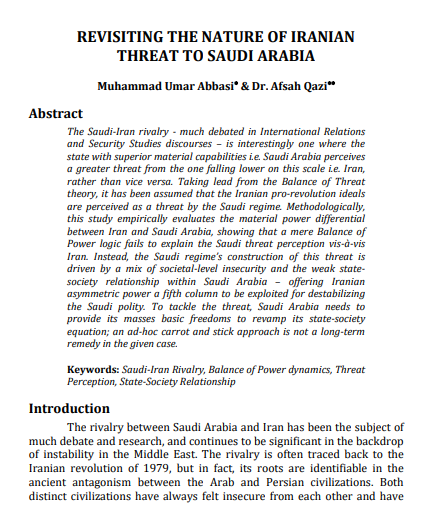REVISITING THE NATURE OF IRANIAN THREAT TO SAUDI ARABIA
Keywords:
Saudi-Iran Rivalry, Balance of Power dynamics, Threat Perception, State-Society RelationshipAbstract
Abstract
The Saudi-Iran rivalry - much debated in International Relations and Security Studies discourses – is interestingly one where the state with superior material capabilities i.e. Saudi Arabia perceives a greater threat from the one falling lower on this scale i.e. Iran, rather than vice versa. Taking lead from the Balance of Threat theory, it has been assumed that the Iranian pro-revolution ideals are perceived as a threat by the Saudi regime. Methodologically, this study empirically evaluates the material power differential between Iran and Saudi Arabia, showing that a mere Balance of Power logic fails to explain the Saudi threat perception vis-à-vis Iran. Instead, the Saudi regime’s construction of this threat is driven by a mix of societal-level insecurity and the weak state society relationship within Saudi Arabia offering Iranian asymmetric power a fifth column to be exploited for destabilizing the Saudi polity. To tackle the threat, Saudi Arabia needs to provide its masses basic freedoms to revamp its state-society equation; an ad-hoc carrot and stick approach is not a long-term remedy in the given case.
References
Barry Buzan and Ole Weaver, Regions and Power: The Structure of
International Security (Cambridge: Cambridge University Press, 2003), 45.
F. Clifford German, “A Tentative Evaluation of World Power,” Journal of
Conflict Resolution 4, (1960): 138-144.
J. David Singer and Melvin Small, The Wages of War, 1816-1965: A Statistical
Handbook (New York: John Willey, 1972)
Global Firepower Index 2018, https://www.globalfirepower.com/countrymilitary-strength-detail.asp?country_id=saudi-arabia & Iran.
Justin McCauley, “The Asymmetry of Asymmetry in the Saudi-Iranian Rivalry,”
Gulf State Analytics, March 11, 2016, http://www.ifimes.org/en/9151
“SIPRI Military Expenditure Database - Data for all Countries 1988-1997,” SIPRI
, https://www.sipri.org/sites/default/files/1_Data%20for%
all%20countries%20from%201988%E2%80%932017%20in%20constant
%20%282016%29%20USD.pdf
Ibid.
"SIPRI Military Expenditure Database - Data for all Countries as Percentage of
Gross Domestic Product 2003-2017,” SIPRI 2018, https://www.sipri.org
Ibid.
“SIPRI - Data for all Countries 1988-1997,” SIPRI 2018.
Ibid.
“SIPRI, Data for all Countries as Percentage of Gross Domestic Product, 2003-
Ibid.
Ibid.
Ibid.
“Global Share of Arms Imports,” Fact Sheet SIPRI,
file:///E:/21%20Jan,%202019/fssipri_at2017_0.pdf.
Ibid.
Ibid.
Ibid.
Ibid.
Global Firepower Index 2018, https://www.globalfirepower.com/countrymilitary-strength-detail.asp?country_id=saudi-arabia&Iran.
Steven Pifer et al., U.S. Nuclear and Extended Deterrence: Considerations and
Challenges - Arms Control Series Paper 3 (Washington, DC: Brookings
Institution, May 2010), 38; International Institute for Strategic Studies (IISS),
The Military Balance 111, no. 1 (2011): 296, 298.
Anthony H. Cordesman, “The Conventional Military,” in The Iran Primer:
Power, Politics, and U.S. Policy, ed., Robin Wright (Washington DC: United
States Institute of Peace Press, December 2010).
Anthony H. Cordesman, “The Saudi Arms Sale: Reinforcing a Strategic
Partnership in the Gulf,” Center for Strategic & International Studies,
November 3, 2010.
Alexander Wilner and Anthony H. Cordesman, “Iran and the Gulf Military
Balance,” Center for Strategic & International Studies, December 1, 2011, 32.
Daniel K. Rosenfield, “Countering Iran with Arms Sales to the Gulf
Cooperation Council States,” Institute for Defense Analyses, 2012,13.
Jeffrey Lewis, “Storm Shadow, Saudi & the MTCR,” Arms Control Wonk, May
, 2011, http://lewis.armscontrolwonk.com/archive/4051/saudi-arabiastorm-shadow-the-mtcr
Daniel K. Rosenfield, “Countering Iran with Arms Sales,” 15.
Ibid., 23.
Mark Gunzinger and Chris Dougherty, “Outside-In: Operating from Range to
Defeat Iran’s Anti-Access and Area-Denial Threats,” Center for Strategic and
Budgetary Assessments CSBA, 2011, https://www.files.ethz.ch/isn/154637/
CSBA_SWA_FNL-WEB.pdf
World Bank National Account Data, https://data.worldbank.org/indicator/
NY.GDP.MKTP.KD.ZG?end=2017&start=2007.
Ibid.
Ibid.
Ibid.
Ibid.
Ibid.
Ibid.
Ibid.
“World Economic Outlook,” International Monetary Fund September 2011,
-203, https://www.imf.org/external/pubs/ft/weo/2011/02/pdf/text.pdf
“Exchange Rate Archive,” Iran’s Central Bank, http://www.cbi.ir/ExRates/
rates_fa.aspx
“Charts of the Week,” Bianco Research, 2012. http://www.arborresearch.
com/bianco/?cat=27&samplecat=7
Mahdieh Aghazadeh, “International Sanctions and their Impacts on Iran’s
Economy,” International Journal of Economics and Finance Studies 6, no. 2,
(2014): 25-41.
Ibid.
Global Firepower Index 2018, https://www.globalfirepower.com/countrymilitary-strength-detail.asp?country_id=saudi-arabia& Iran
Ibid.
Ibid.
Ibid.
Global Firepower Index 2018, https://www.globalfirepower.com/countrymilitary-strength-detail.asp?country_id=saudi-arabia.
“Chapter Seven: Middle East and North Africa,” The Military Balance 118, no.
, (2019): 333.doi: 10.1080/04597222.2018.1416983, ISSN: 0459-7222.
Ibid.
Firepower Index 2018.
“Chapter Seven,” The Military Balance, (2019): 358.
Ibid.
Ibid.
Justin McCauley, “The Asymmetry of Asymmetry in the Saudi-Iranian Rivalry,”
Gulf State Analytics, March 24, 2016.
Ibid.
Ibid.
Justin McCauley, “The Asymmetry of Asymmetry in the Saudi-Iranian Rivalry.”
Chase Winter, “Iran's Military Power: What you Need to Know?” DW, August
, 2018, https://www.dw.com/en/irans-military-power-what-you-need-toknow/a-43756843.
Michael Eisenstaedt, “Deter and Contain: Dealing with a Nuclear Iran -
Testimony before the Committee on Armed Services,” U.S. House of
Representatives, February 1, 2006.
Ibid.
Mark Gunzinger and Chris Dougherty, “Outside-In: Operating from Range to
Defeat Iran’s Anti-Access and Area-Denial Threats,” Center for Strategic and
Budgetary Assessments (CSBA), 2011.
Daniel K. Rosenfield, “Countering Iran with Arms Sales to the Gulf
Cooperation Council States,”2012, 3-4.
Frederic Wehrey et al., Dangerous But Not Omnipotent: Exploring the Reach
and Limitations of Iranian Power in the Middle East (Santa Monica, CA: RAND
Corp., 2009), XIX–XX.
Ibid.
Stephen Walt, The Origin of Alliances (New York: Cornell University Press,
, 22-26.
Taimur Khan, “Saudi Prince Muhammad Bin Salman’s Warning to Iran,” The
National, May 3, 2017.
Saudi Foreign Minister, “Iran is the Biggest Sponsor of Terrorism,” Defence
News, February 21, 2017.
Muhammad Bazzi, “The Great Debate: Saudi Arabia faces many Threats, and
Iran isn’t at the Top of the List,” Reuters Blog, May 28, 2015.

Downloads
Published
How to Cite
Issue
Section
License
License Terms








